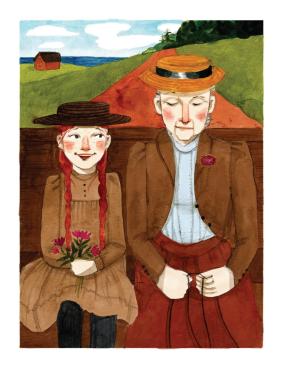Anne’s Kindred Spirits – Kallie George (adapting L.M. Montgomery) and Abigail Halpin, Tundra Books, 2019

Anyone who has read Anne of Green Gables knows that friendship is not just a pleasant link between two people, but a life-transforming bond. If you are a poor, bookish orphan who has never found anyone as understanding as her own reflection in a mirror, meeting someone who becomes a “bosom friend,” and a “kindred spirit,” is an affirmation of her own value as a human being. In Kallie George and Abigail Halpin’s second in a series of adaptations of Anne for middle grade readers, they once again achieve the near-impossible, preserving the eloquence and passion of Montgomery’s work while making it accessible to those who will read the original book a bit later.

As in their earlier volume, George and Halpin focus on a limited series of events, rather than trying to encapsulate the whole classic. Anne meets Diana Barry, who loves reading as much as she does, although Diana’s “hair was black as a raven’s wing, not red.” They learn that their inner similarities outweigh their outer differences, and make a vow, “to be faithful to my bosom friend as long as the sun and moon endure.” (link to image of girls holding hands) The meeting between Anne and Diana was a close call. Having been warned by her guardian, Marilla, to downplay her irrepressible oddness, Anne almost sabotages the new bond by responding to Mrs. Barry’s formulaic “How are you?” with “I’m good in body, but rumpled in spirits, ma’am.” Even as George simplifies some of the original novel’s language, she retains its intensity and depth. There have been many other attempts to adapt classics for a younger audience; this one is exceptional.

The book also includes the episode of Anne’s unjust punishment by Marilla when a favorite brooch disappears from Marilla’s pincushion. George conveys the frustration of a child who is misunderstood by adults, but is not free to express that frustration. Marilla is also frustrated at her apparent failure to have taught moral lessons to her foster child. Halpin’s beautifully profound illustration of this sorrow shows Marilla and her bother Matthew seated at a table, with a sliced pie in the center. Matthew’s plate is empty, but Marilla’s serving is untouched. She rests her head on her elbow and looks overwhelmed, trying to process the facts: “I’ve looked everywhere…Anne took it. That’s the plain, ugly truth.” Every picture in the book is in close harmony with the accompanying text; children will truly read both text and pictures. (link to image)

In another image, Anne leans out the window in her nightgown, her braids lifted by the wind like a Prince Edward Island Rapunzel. Instead of waiting for her prince, she is terrified that Diana will not understand why she is not attending the community picnic.

Another picture subtly captures Anne and Marilla’s opposite personalities. They are riding in a their carriage, Marilla holding the reins firmly and looking down, but also listening to Anne, whose verbal stream both puzzles and amuses her: “Do you think amethysts might be the souls of flowers?” The book’s final two-page spread is really a testament to the author and artist’s vision. Everyone is enjoying the closeness of a town too small to have strangers; Halpin has introduced people of color, who have a rich history in the Maritime Provinces. Their presence in the scene is one more piece of evidence of Halpin’s deliberate artistic choices.

Reading Anne’s Kindred Spirits, and sharing it with children, is an elevating experience. The book is a reminder of how innovation and awareness of tradition can work together to make a great children’s book.

3 thoughts on “Friendship that Starts in the Soul”